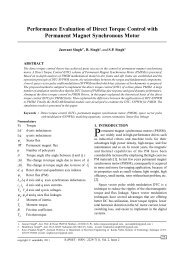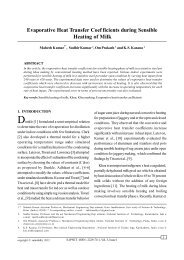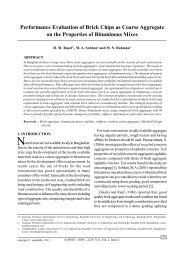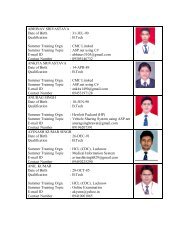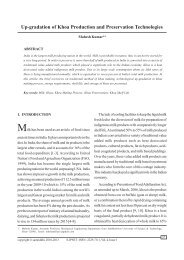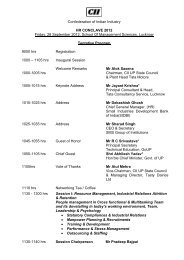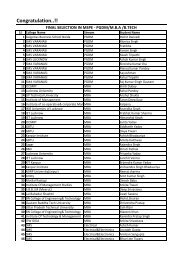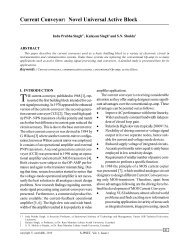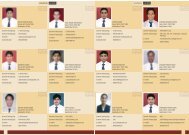Electronics Spectra - SMS Lucknow
Electronics Spectra - SMS Lucknow
Electronics Spectra - SMS Lucknow
You also want an ePaper? Increase the reach of your titles
YUMPU automatically turns print PDFs into web optimized ePapers that Google loves.
<strong>SMS</strong> Institute of Technology, L ucknow<br />
Department of <strong>Electronics</strong> & Co mmunication<br />
studying the behavior of complex systems.<br />
Even with modern-day computers,<br />
however, there are still two main<br />
limitations facing atomistic simulations:<br />
system size and simulation time. While<br />
recent developments in parallel computer<br />
design and algorithms ha ve<br />
made considerable progress in enlarging<br />
the system size that can b e accessed<br />
using atomistic simulat ions,<br />
methods for shortening the simulation<br />
time still remain relatively unexplored.<br />
One example where such methods<br />
will be useful is in the determination<br />
of the lowest energy conf igurations<br />
of a collection of atoms. Because<br />
the number of candidate local energy<br />
minima grows exponentially with the<br />
number of atoms, the computational<br />
effort scales exponentially with problem<br />
size, making it a member of the<br />
NP-hard problem class.<br />
For a few atoms, the ground state<br />
can sometimes be found by a br ute<br />
force search of configuration space.<br />
For up to ten or twenty atoms, depending<br />
upon the potential, simulated<br />
annealing may be employed to g enerate<br />
some candidate ground st ate<br />
configurations. For more atoms than<br />
this, attempts to use simulate d annealing<br />
to find the global energy minimum<br />
are frustrated by high ene rgy<br />
barriers which trap the simulation in<br />
one of the numerous metastable configurations.<br />
An algorithm is needed which can<br />
‘hop’ from one minimum to anot her<br />
and permit an efficient sampli ng of<br />
phase space. Our approach is based<br />
on the genetic algorithm (GA), an<br />
optimization strategy inspired by the<br />
Darwinian evolution process. Starting<br />
with a population of candidate structures,<br />
we relax these candidat es to<br />
the nearest local minimum. Using the<br />
relaxed energies as the criteria of fitness,<br />
a fraction of the popula tion is<br />
selected as “parents.” The next generation<br />
of candidate structures is produced<br />
by “mating” these parents. The<br />
process is repeated until the ground<br />
state structure is located.<br />
APPLICATIONS OF<br />
GENERIC ALGORITHM<br />
Genetic algorithms are a very effective<br />
way of quickly finding a reasonable<br />
solution to a complex problem.<br />
Granted they aren’t insta ntaneous,<br />
or even close, but they do an<br />
excellent job of searching through a<br />
large and complex search space. Genetic<br />
algorithms are most effective in<br />
a search space for which little is known.<br />
You may know exactly what you want<br />
a solution to do but have no idea how<br />
you want it to go about doing it. This<br />
is where genetic algorithms th rive.<br />
They produce solutions that solve the<br />
problem in ways you may never have<br />
even considered. Then again, they can<br />
also produce solutions that only work<br />
within the test environment an d<br />
flounder once you try to use them in<br />
the real world. Put simply: use genetic<br />
algorithms for everything you cannot<br />
easily do with another algorithm.<br />
Originally defined by the crea tor<br />
John Holland, the goal of genetic algorithm<br />
was to abstract and rigorously<br />
explain the adaptive processes of<br />
natural systems and to develop ways<br />
in which natural adaptation might aid<br />
computer systems and software. This<br />
lead to important discoveries in both<br />
the natural and artificial realms. <br />
Smart card is just one aspect of a whole smart ID<br />
A smart card is essentially a card<br />
or token comprising a secure m icro<br />
processor core and non volatil e<br />
memory. It is like a visiting card, with<br />
a tiny computer chip inside it.<br />
It can store information and communicate<br />
with smart card termi nals<br />
that can read and write that information<br />
to the card, as well as act as interface<br />
between smart card and larger<br />
network.<br />
It is highly secured. At a bas ic<br />
level, smart card can perform four<br />
functions like data storage, identification,<br />
authentication and appli cation<br />
processing.<br />
In an ideal situation, a person can<br />
carry just a single smart card that acts<br />
as a credit card, cash card, ration card,<br />
PAN card, voter's card and eve n a<br />
passport.<br />
In this, security is in the form of<br />
PIN number, passwords etc... w ith<br />
sophisticated hacking equipmen t,<br />
smart card data can be interce pted.<br />
A secure processor core, on the other<br />
hand, would be tamper-resistant and<br />
prevent retrieval or modification of onchip<br />
physical attacks.<br />
The functioning of the smart card,<br />
especially the communication task requires<br />
power. The mode of performing<br />
the power giving process depends<br />
largely on the functions perfo rmed<br />
and the power required for these.<br />
Smart ID's are promising to he lp<br />
Shashank Shekhar Singh<br />
EC - II year<br />
government agencies tackle the se<br />
upcoming challenges better. As the<br />
technology reasonably matures, this<br />
is indeed the right time to in troduce<br />
smart ID's.<br />
<br />
27 <strong>Electronics</strong> <strong>Spectra</strong>, 2010



